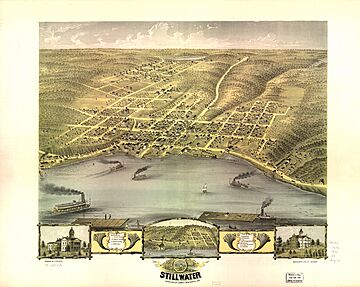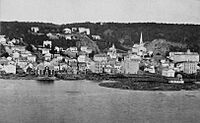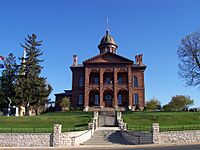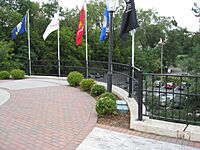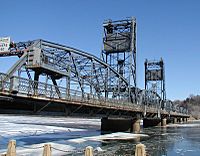Stillwater, Minnesota facts for kids
Quick facts for kids
Stillwater
|
||
|---|---|---|
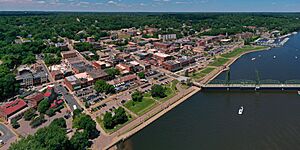
The waterfront of Stillwater on the St. Croix River
|
||
|
||
| Nickname(s):
The Birthplace of Minnesota
|
||
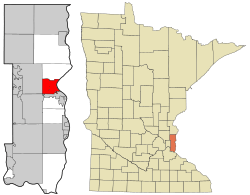
Location of the city of Stillwater
within Washington County, Minnesota |
||
| Country | United States | |
| State | Minnesota | |
| County | Washington | |
| First settled | October 26, 1843 | |
| Area | ||
| • Total | 9.07 sq mi (23.50 km2) | |
| • Land | 8.05 sq mi (20.84 km2) | |
| • Water | 1.03 sq mi (2.66 km2) | |
| Elevation | 866 ft (264 m) | |
| Population
(2020)
|
||
| • Total | 19,394 | |
| • Density | 2,410.39/sq mi (930.66/km2) | |
| Time zone | UTC−6 (CST) | |
| • Summer (DST) | UTC−5 (CDT) | |
| ZIP Codes |
55082, 55083
|
|
| Area code(s) | 651 | |
| FIPS code | 27-62824 | |
| GNIS feature ID | 2395969 | |
Stillwater is a city in the U.S. state of Minnesota. It is the main city of Washington County. Stillwater is part of the Minneapolis–Saint Paul area. It sits on the west bank of the St. Croix River, across from Houlton, Wisconsin. In 2020, Stillwater had 19,394 people living there. Stillwater is often called "the birthplace of Minnesota" because it played a big role in the state's history.
Contents
Geography and Climate
Stillwater covers about 7.98 square miles (20.67 square kilometers). Most of this area is land, with some water. Key roads that go through the city include State Highways 36, 95, and 96.
The city gets about 42 inches (107 cm) of snow each year. It also receives about 24 inches (61 cm) of rain annually. On average, there are 14 days a year when the temperature goes above 90°F (32°C).
City Name and Its Meaning
The name "Stillwater" was suggested in 1843 by John McKusick. He built the first sawmill in the area. McKusick later became a state senator. The name comes from how calm the St. Croix River is near the city center. It is also thought that McKusick remembered Stillwater, Maine, where he used to live.
Long before European Americans arrived, different Native American groups lived here for thousands of years. The Dakota people called this area Hoġan Wanḳe Kin. This name meant "the place where the fish lies". It came from a story about a man who turned into a giant fish and then into a sandbar.
The Ojibwe people had a similar name, Giigoonzh-agomod, which meant "where the fish floats". Their legend also tells of a man turning into a giant fish that floated in the lake. He then became a piece of land crossing the lake.
History of Stillwater
In the 1830s, people from Europe and America began moving west into this area. The U.S. government made agreements with the local Ojibwe and Dakota nations. These agreements, signed in 1837, allowed settlers to live in the St. Croix Valley.
Stillwater was founded on October 26, 1843. Four partners started the Stillwater Lumber Company. Settlers came to the area because of its many trees and the river for transportation. Stillwater is one of Minnesota's oldest towns, even older than Minneapolis. It officially became a city on March 4, 1854, the same day as St. Paul.
Stillwater is often called the "birthplace of Minnesota." In 1848, a special meeting was held in Stillwater. This meeting started the process of making Minnesota a state. Minnesota was first part of the Wisconsin Territory. It became its own territory in 1849. Then, as more people moved there, it became a state in 1858.
To show Stillwater's importance, the meeting chose three main cities for important public places. Saint Paul became the capital. The University of Minnesota was built in Minneapolis. Stillwater became the home of the territory's first prison. The Minnesota Territorial Prison opened in 1853. Famous prisoners like Cole, Jim, and Bob Younger, from the James–Younger Gang, were held there.
Lumbering was the biggest industry in the St. Croix River Valley in the late 1800s. For many years, loggers sent large groups of logs down the St. Croix River. These logs were gathered at the St. Croix Boom Site, a few miles upstream from Stillwater. They were then processed in Stillwater's many sawmills. Steamboats were also very popular on the river from 1860 to 1890. Some steamboats are still used today for fun trips.
David Swain ran a shipyard and engine factory in Stillwater. In the early 1900s, steamboats like the Verne Swain and the Capitol began taking passengers to other cities along the river.
During the American Civil War, Stillwater sent soldiers to fight for the Union. These soldiers were part of groups like the 1st Minnesota Volunteer Infantry Company B.
On October 18, 1921, Charles Strite invented the automatic pop-up bread toaster in Stillwater. By 1926, the Toastmaster Company started selling the first home toaster using his invention. In 1923, Nelson's Ice Cream parlor opened in the city.
In 1931, the Stillwater lift bridge was finished. It crosses the St. Croix River. The bridge cost $460,174, shared by Minnesota and Wisconsin. This lift bridge is one of the city's most famous landmarks. It was part of Minnesota State Highway 36 until 2017, when cars could no longer use it. In 2020, it became part of a five-mile walking and biking trail loop that goes through Stillwater and Houlton, Wisconsin.
In 1996, Stillwater agreed to add land from Stillwater Township. In 2015, the city council approved adding the last of this land. The city's western edge is now Manning Avenue (County Road 15). The northern edge is mostly Minnesota Highway 96.
Gallery
Population Information
| Historical population | |||
|---|---|---|---|
| Census | Pop. | %± | |
| 1860 | 2,380 | — | |
| 1870 | 4,124 | 73.3% | |
| 1880 | 9,055 | 119.6% | |
| 1890 | 11,260 | 24.4% | |
| 1900 | 12,318 | 9.4% | |
| 1910 | 10,198 | −17.2% | |
| 1920 | 7,735 | −24.2% | |
| 1930 | 7,173 | −7.3% | |
| 1940 | 7,013 | −2.2% | |
| 1950 | 7,674 | 9.4% | |
| 1960 | 8,310 | 8.3% | |
| 1970 | 10,191 | 22.6% | |
| 1980 | 12,290 | 20.6% | |
| 1990 | 13,882 | 13.0% | |
| 2000 | 15,143 | 9.1% | |
| 2010 | 18,225 | 20.4% | |
| 2020 | 19,394 | 6.4% | |
| U.S. Decennial Census | |||
2010 Census Data
In 2010, Stillwater had 18,225 people living there. There were 7,075 households and 4,885 families. The city had about 2,618 people per square mile (1,011 per square kilometer).
Most people (95.1%) were White. About 1.0% were African American, 0.4% Native American, and 1.1% Asian. About 1.9% of the population was Hispanic or Latino.
The average age in the city was 40 years old. About 26.5% of residents were under 18. About 12.8% were 65 years or older. There were slightly more females (51.5%) than males (48.5%).
2020 Census Data
As of the 2020 census, Stillwater's population was 19,394 people.
Most residents (89.9%) identified as White alone. Other groups included 1.7% Black or African American, 0.3% American Indian and Alaska Native, and 1.5% Asian. About 3.2% of the population was Hispanic or Latino.
In 2016–2020, the average household income in Stillwater was $91,947. The average family income was $109,151. About 5.2% of all people and 3.3% of families lived below the poverty line. This included 4.6% of those under 18 and 5.9% of those 65 or older. Most adults (96.4%) had a high school diploma or higher. Also, 46.6% had a bachelor's degree or higher.
Education
Stillwater has different types of schools for kids. These include public schools, public charter schools, and private schools. The city is part of the Stillwater Area Public Schools system. The closest high school is Stillwater Area High School in Oak Park Heights, Minnesota.
Notable People from Stillwater
Many interesting people have connections to Stillwater:
- Thomas J. Abercrombie: A photographer and the first journalist to reach the South Pole. He was born in Stillwater.
- Michele Bachmann: A U.S. Representative who lived in Stillwater.
- Noah Cates: A professional ice hockey player for the Philadelphia Flyers. He was born in Stillwater.
- Jessie Diggins: An Olympic gold medalist in cross-country skiing. She went to high school in Stillwater.
- Phil Housley: A Hockey Hall of Fame player and NHL coach. He coached in Stillwater.
- Jessica Lange: A famous actress who lived in Stillwater.
- Denis McDonough: The 11th Secretary of Veterans Affairs and White House Chief of Staff for President Obama. He was born in Stillwater.
- Glen Perkins: A pitcher for the Minnesota Twins. He was born in Stillwater.
- Sam Shepard: A well-known playwright and actor who lived in Stillwater.
- Zach Sobiech: A musical artist who wrote the hit song “Clouds” after being diagnosed with cancer. His story inspired a Disney movie.
- Rich Sommer: An actor who grew up in Stillwater.
- Thomas Vanek: An ice hockey forward for the Minnesota Wild who lives in Stillwater.
See also
 In Spanish: Stillwater (Minnesota) para niños
In Spanish: Stillwater (Minnesota) para niños



